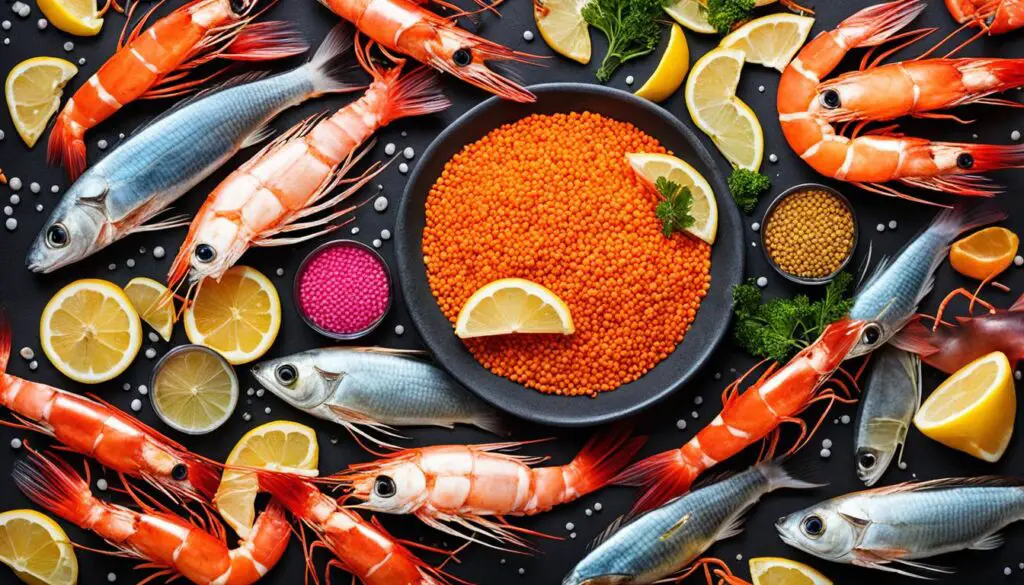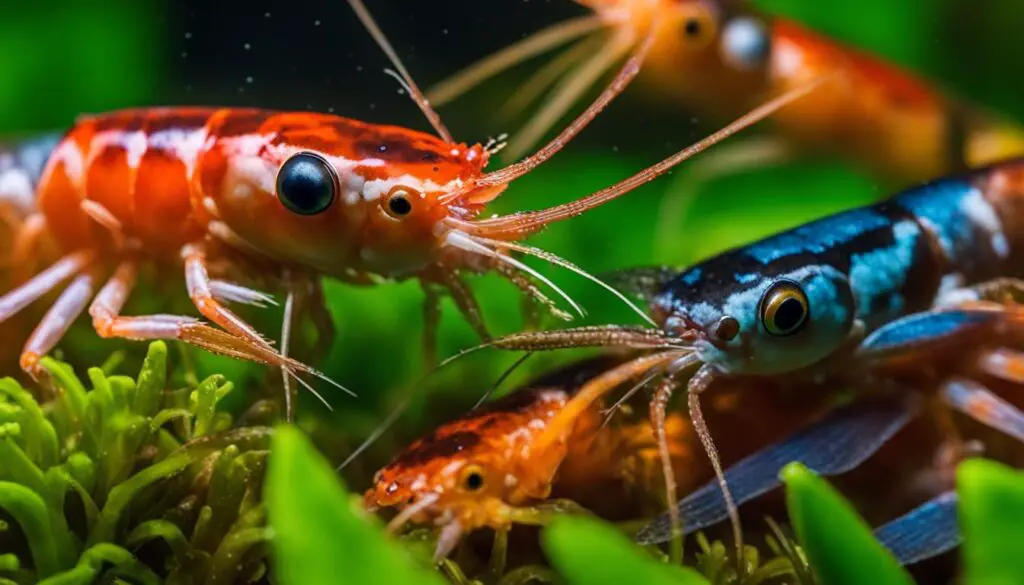There is some debate about whether shrimp can safely consume fish food. If you’re a shrimp owner or considering adding these fascinating creatures to your aquarium, it’s important to understand their dietary needs. In this article, we will explore whether shrimp can eat fish food, what shrimps eat in the wild and in captivity, considerations for feeding shrimp, and tips for feeding shrimp in a community tank.
Key Takeaways:
- Shrimp can safely consume fish food, but it’s important to avoid fish foods containing copper.
- Shrimp primarily eat algae, detritus, and organic matter in the wild.
- In captivity, shrimp can be fed specialized shrimp pellets or flakes, freeze-dried or frozen foods, and vegetables.
- Provide a well-balanced diet for shrimp that includes protein, vitamins, minerals, and fiber.
- Avoid overfeeding shrimp to prevent water quality issues.
What Do Shrimps Eat in the Wild and in Captivity?
In the wild, shrimp have a diverse diet consisting of algae, detritus, and other organic matter. As scavengers, they have the ability to eat almost anything they come across. However, when keeping shrimp in captivity, it is important to provide a balanced diet that meets their nutritional needs for optimal health and growth.
One common question that shrimp keepers often ask is, “Can shrimp eat fish food?” The answer is yes, shrimp can consume fish food as part of their diet, but certain considerations should be taken into account. It is essential to choose fish foods without copper ingredients, as excessive copper can be harmful to shrimp. However, most fish foods available on the market are safe for shrimp.
Aside from fish food, there are several other options for feeding pet shrimps. Specialized shrimp pellets or flakes can be offered, providing a complete and balanced meal. Additionally, freeze-dried or frozen foods such as krill or bloodworms can be given as occasional treats to supplement their diet with extra nutrients.
Vegetables are also a great addition to a shrimp’s diet, as they provide essential fiber. Spinach, zucchini, and cucumber are excellent choices that can be offered in small portions. These vegetables not only offer nutritional benefits but also provide variety in taste and texture for shrimp.
Shrimp keepers who want to provide their pets with even more variety often feed them live or frozen foods like brine shrimp or daphnia. These foods mimic the natural prey of shrimp and offer an additional source of protein. However, it is important to ensure that these foods come from reputable sources and are properly cleaned before feeding them to the shrimp.
To summarize, the best food for shrimp includes a combination of fish food without copper, specialized shrimp pellets or flakes, freeze-dried or frozen foods, and vegetables. It’s important to vary their diet and avoid overfeeding to prevent water quality issues. Providing a balanced and diverse menu will help ensure the health and vitality of pet shrimps.
Food Options for Pet Shrimps
| Food Type | Description |
|---|---|
| Fish Food | Brands like AZOO, New Life Spectrum, and Hikari offer fish foods without copper ingredients that are safe for shrimp. |
| Shrimp Pellets or Flakes | Specialized shrimp pellets or flakes provide a complete and balanced diet for shrimp. |
| Freeze-Dried or Frozen Foods | Krill and bloodworms are excellent options for adding extra nutrients to a shrimp’s diet. |
| Vegetables | Spinach, zucchini, and cucumber offer fiber and variety to a shrimp’s diet. |
| Live or Frozen Foods | Brine shrimp and daphnia mimic the natural prey of shrimp and provide additional protein. |
Considerations for Feeding Shrimp
When it comes to feeding your shrimp, there are a few important considerations to keep in mind. Providing a well-balanced diet that meets their nutritional needs is crucial for their optimal health. Shrimp require a combination of protein, vitamins, minerals, and fiber to thrive.
One key aspect of feeding shrimp is to avoid overfeeding. Excess food can lead to water quality problems, such as an increase in ammonia levels and the growth of harmful bacteria. To prevent this, it’s best to feed your shrimp small amounts of food at a time. Only provide what they can consume within a few minutes.
If any uneaten food is left in the tank after feeding, it should be promptly removed. This prevents it from decaying and polluting the water, maintaining a clean and healthy environment for your shrimp to thrive in.
Another consideration is the timing of feeding. Shrimp are most active and likely to eat their food during the evening or at night. By feeding them at these times, you increase the chances of them consuming the food and benefiting from its nutritional value.
Feeding your shrimp a varied diet is also important. While fish food can be a suitable option for shrimp, it’s recommended to supplement their diet with other foods to ensure they receive a wide range of nutrients. Specialized shrimp pellets or flakes, as well as freeze-dried or frozen foods like krill or bloodworms, can be offered as alternative food sources.
The Importance of Nutrition for Shrimp
“A well-balanced diet is crucial for the optimal health of shrimp. Providing them with the necessary nutrients contributes to their overall well-being and enhances their growth and vitality.”
Shrimp require protein for growth, molting, and reproduction. It is essential for the development of their exoskeleton and the formation of new cells. Additionally, vitamins and minerals play a vital role in supporting their immune system and other physiological processes.
Fiber is another important component of their diet as it aids in digestion and prevents constipation. Vegetables like spinach, zucchini, and cucumber can be included in their diet as a source of fiber.
In summary, when feeding shrimp, it’s crucial to provide a well-balanced diet that meets their nutritional needs. Avoid overfeeding, remove any uneaten food promptly, and feed them during their active hours. By considering these factors, you can ensure the health and well-being of your shrimp.

Dietary Considerations for Optimal Shrimp Health
| Nutrition | Role | Sources |
|---|---|---|
| Protein | Promotes growth, molting, and reproduction | Fish food, specialized shrimp pellets, freeze-dried/frozen foods |
| Vitamins and Minerals | Support immune system and physiological processes | Fish food, specialized shrimp pellets, vegetables |
| Fiber | Aids in digestion, prevents constipation | Vegetables (spinach, zucchini, cucumber) |
Tips for Feeding Shrimp in a Community Tank
If you have a community tank with other fish, it’s important to choose fish food that is safe for both the fish and the shrimp. As mentioned earlier, fish foods without copper ingredients are generally considered safe for shrimp. It’s also important to consider the preferences and dietary needs of the other tank inhabitants.
Some fish may require a specialized diet that is not suitable for shrimp. It’s recommended to observe the feeding habits of all the tank inhabitants and adjust the feeding regimen accordingly. Additionally, it’s a good idea to provide hiding places or feeding dishes for the shrimp to prevent their food from being eaten by other fish.
| Tips for Feeding Shrimp in a Community Tank | Benefits |
|---|---|
| Choose fish food without copper ingredients | – Ensures the safety of both fish and shrimp – Prevents potential harm from copper |
| Consider the preferences and dietary needs of other tank inhabitants | – Helps maintain overall tank health – Avoids conflicts in food consumption – Promotes the well-being of all tank inhabitants |
| Observe feeding habits and adjust feeding regimen accordingly | – Ensures all tank inhabitants receive adequate nutrition – Prevents overfeeding or underfeeding |
| Provide hiding places or feeding dishes for shrimp | – Prevents other fish from eating shrimp’s food – Reduces competition during feeding time |
By following these tips, you can create a harmonious community tank where both fish and shrimp thrive. Remember to prioritize the well-being of all tank inhabitants and provide a safe and suitable environment for each species.

Conclusion
In conclusion, shrimp can safely consume fish food as part of their diet. While it’s important to avoid fish foods with copper ingredients, most fish foods on the market are considered safe for shrimp. It’s essential to provide a balanced diet that meets their nutritional needs, including protein, vitamins, minerals, and fiber.
Variations in their diet can be achieved by offering specialized shrimp foods, freeze-dried or frozen foods, and vegetables. Shrimp pellets or flakes specifically formulated for shrimp can ensure they get the necessary nutrients. Additionally, offering freeze-dried or frozen foods like krill or bloodworms can provide variety and mimic their natural diet. Vegetables such as spinach, zucchini, and cucumber can serve as a source of fiber and additional nutrients.
Feeding shrimp should be done in small amounts to prevent overfeeding and maintain good water quality. Shrimp should only be given what they can consume within a few minutes, and any uneaten food should be promptly removed to avoid water pollution. If keeping shrimp in a community tank, it’s important to consider the dietary needs of other tank inhabitants and choose fish food that is both safe for shrimp and suitable for other fish in the tank.
FAQ
Can shrimp safely consume fish food?
There is some debate about whether shrimp can safely consume fish food. Some sources suggest that fish foods containing copper should be avoided, as copper can be harmful to shrimp. However, other sources argue that a small amount of copper is actually necessary for shrimp and other invertebrates to survive. Overall, it is believed that just about any fish food can be safely consumed by shrimp, but it’s important to avoid overfeeding them protein-rich diets, as this can cause problems with their growth and molting.
What do shrimps eat in the wild and in captivity?
In the wild, shrimp primarily feed on algae, detritus, and other organic matter. They are scavengers and will eat almost anything they come across. In captivity, shrimp can be fed specialized shrimp pellets or flakes, as well as freeze-dried or frozen foods like krill or bloodworms. Vegetables like spinach, zucchini, and cucumber can also be offered as a source of fiber. Some shrimp keepers even feed their shrimp live or frozen foods like brine shrimp or daphnia. It’s important to vary their diet and avoid overfeeding to prevent water quality issues.
What are the considerations for feeding shrimp?
When feeding shrimp, it’s important to provide a well-balanced diet that meets their nutritional needs. Shrimp require protein, vitamins, minerals, and fiber for optimal health. It’s crucial to avoid overfeeding, as excess food can lead to water quality problems. Shrimp should be fed small amounts of food, only what they can consume within a few minutes. Uneaten food should be removed promptly to prevent it from decaying and polluting the water. It’s recommended to feed shrimp in the evening or at night when they are most active and likely to eat the food.
What are the tips for feeding shrimp in a community tank?
If you have a community tank with other fish, it’s important to choose fish food that is safe for both the fish and the shrimp. Fish foods without copper ingredients are generally considered safe for shrimp. It’s also important to consider the preferences and dietary needs of the other tank inhabitants. Some fish may require a specialized diet that is not suitable for shrimp. It’s recommended to observe the feeding habits of all the tank inhabitants and adjust the feeding regimen accordingly. Additionally, it’s a good idea to provide hiding places or feeding dishes for the shrimp to prevent their food from being eaten by other fish.

